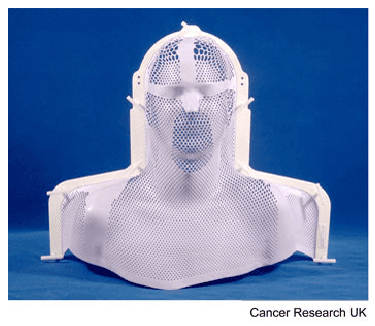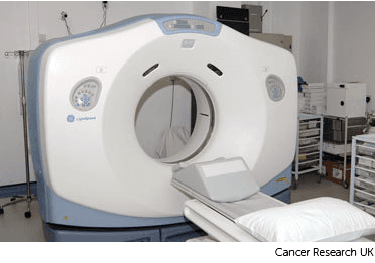Radiotherapy
Your treatment team might make a mask for you if you are having radiotherapy to your head and neck area. They are also called radiotherapy shells.
Your treatment team will make one for you to wear during your treatment sessions. It will help you to keep very still when you have radiotherapy.
The radiographers make marks on the mask and use the marks to line up the radiotherapy machine for each treatment.
The process of making the shell can vary slightly between hospitals. It usually takes around 30 minutes.
You need to wear clothes that you can easily take off from your neck and chest. You also need to take off any jewellery from that area.
Facial hair, long hair or dreadlocks can make it difficult to mould the shell. The radiotherapy staff will tell you if you need to shave or to tie your hair back.
A technician uses a special kind of plastic that they heat in warm water. This makes it soft and pliable. They put the plastic on to your face, neck and chest so that it moulds exactly.
After a few minutes the plastic gets hard. The technician takes the mask off and it is ready to use.

You may also have a dental impression made with gel. The technician puts the gel into your mouth and takes an impression of your teeth. This takes between 5 and 10 minutes. The technician also makes an impression of your lower jaw and neck. The whole visit takes about 30 minutes.
The video below shows what happens when you have your mesh mask made. The video is about 1 and a half minutes long.
You usually have a planning CT scan in the radiotherapy department.
The scan shows the cancer and the area around it. You might have other types of scans or x-rays to help your treatment team plan your radiotherapy. The plan they create is just for you.

Your radiographers tell you what is going to happen. They help you into position on the scan couch. You might have a type of firm cushion called a vacbag to help you keep still.
The CT scanner couch is the same type of bed that you lie on for your treatment sessions. You need to lie very still. Tell your radiographers if you aren't comfortable.
You might need an injection of contrast into a vein in your hand. This is a dye that helps body tissues show up more clearly on the scan.
Before you have the contrast, your radiographer asks you about any medical conditions or allergies. Some people are allergic to the contrast.
Once you are in position your radiographers put some markers on the mask. They move the couch up and through the scanner. They then leave the room and the scan starts.
The scan takes about 5 minutes. You won't feel anything. Your radiographers can see and hear you from the CT control area where they operate the scanner.
You lie on the scanner couch with the treatment area exposed.
Watch our video about radiotherapy planning. It is just under 3 minutes long.
You might have to wait a few days or up to 3 weeks before you start treatment.
During this time the physicists and your radiotherapy doctor (clinical oncologist) decide the final details of your radiotherapy plan. They make sure that the area of the cancer will receive a high dose and nearby areas receive a low dose. This reduces the side effects you might get during and after treatment.
You might have radiotherapy for salivary gland cancer on its own or after surgery.
Find out when you might have radiotherapy and what happens during treatment
Last reviewed: 24 Apr 2023
Next review due: 24 Apr 2026
External radiotherapy uses a machine outside the body to direct radiation beams at the cancer. It uses high energy rays similar to x-rays to kill cancer cells.
Radiotherapy for salivary gland has side effects. You might have sore skin, a sore or dry mouth and tiredness. Most side effects gradually go away in the weeks or months after treatment.
Treatment for salivary gland cancer depends on where the cancer is, the size, whether it has spread anywhere else and your health.
Getting practical and emotional support can help you to cope with a diagnosis of salivary gland cancer. It can also help you with life during and after treatment.
Salivary gland cancer can start in any of the glands that make spit (saliva). As well as 3 major pairs of salivary glands we have over 600 smaller, minor salivary glands throughout the lining of the mouth and throat.

About Cancer generously supported by Dangoor Education since 2010. Learn more about Dangoor Education
Search our clinical trials database for all cancer trials and studies recruiting in the UK.
Connect with other people affected by cancer and share your experiences.
Questions about cancer? Call freephone 0808 800 40 40 from 9 to 5 - Monday to Friday. Alternatively, you can email us.